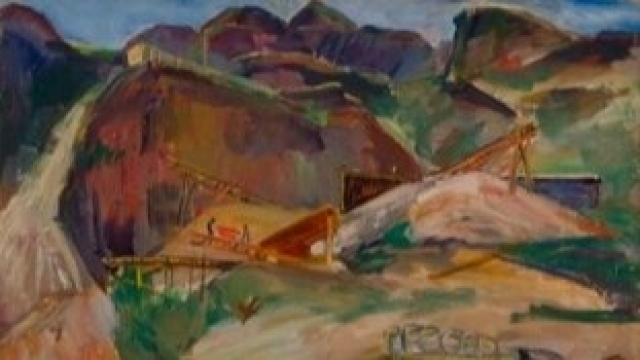
Martiros Saryan “Dzorages”
On September 17, 1922, writer and publicist Marieta Shahinyan, representing the newspaper Pravda, embarked on an extensive journey through the Transcaucasian republics. She traveled across Armenia, writing reviews, monographs, and detailed articles about the country's landscapes, people, and their culture.
Shahinyan also played an active role in the construction of Dzorages, designated as a “Shock Construction Project” of Soviet Armenia. This initiative began in 1927 and lasted about five years, with its experiences later serving as the central theme for her novel 'Hydrocentral' (1931).
During her travels around Armenia, Marieta Shahinyan became acquainted with prominent figures of Armenian art and culture. It is said that Martiros Saryan, inspired by Shahinyan’s stories about the construction of Dzorages—an intricate waterworks featuring unprecedented engineering solutions—visited the site and chose to capture his impressions of this unique construction on canvas.
In 1929, he created his renowned painting "Dzorages," which debuted in May 1930 at the inaugural exhibition of Armenian fine arts, held at the Yerevan State Theater. Saryan showcased ten works at the exhibition, including "Dzorages."
In Saryan's work, nature is not merely a backdrop but an active protagonist, embodying national identity and culture. His distinctive style is evident in the painting "Dzorages," where vibrant colors and simple yet rich shapes blend with natural scenes. Light, color, and landscapes convey the harmony between people and nature.
Upon closer inspection, it's easy to notice that the letters СССР (USSR) are distinctly outlined by the contours of the cargo loaded onto the back of the truck.
Saryan’s painting "Dzorages" remained in the storage rooms of the National Gallery of Armenia in a deplorable condition for decades. The gallery houses many such works—around 15,000 out of more than 40,000 exhibits—that are significantly damaged and have never been restored.
Saryan’s canvas was taken out of the gallery’s storerooms only in the summer of 2019. JTI Armenia selected this painting from a list of works slated for restoration. A council of 15 specialists reviewed and approved the work plan, after which the restorers began the process of restoring the canvas.
According to experts, the restoration of Martiros Saryan’s painting "Dzorages" was "unprecedentedly difficult." The canvas is made of two pieces sewn together. To ensure the seam running through the center remained invisible, restorers spent over a month connecting the two sections using a method that had never been employed before.
"It was a woven fabric. We removed the horizontal threads of the 'sleeve,' leaving only the vertical support threads. The connection of the two canvases was made through these 'related' threads. The challenge was that each thread had to be processed; some were removed due to their thickness, while the thread on the right side was glued to the canvas on the left, and vice versa," Artashes Abrahamyan, a restorer, told to the Mediamax agency.
After completing this complex stage, the inner layer was secured, and the canvas was folded in half. The restoration took six months in total. Today, this remarkable work by the famous painter is on display at the National Gallery of Armenia.
Source: ECTI
Martiros Saryan “Dzorages”